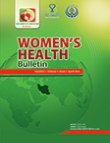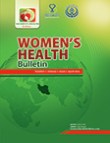فهرست مطالب

Women’s Health Bulletin
Volume:10 Issue: 4, Oct 2023
- تاریخ انتشار: 1402/07/09
- تعداد عناوین: 7
-
-
Page 1Background
Women diagnosed with breast cancer may be more inclined to take preventive measures if they believe they have control over their health. This study explored the mediating influence of cancer self-efficacy in the association between health locus of control (HLC) and health-promoting behaviors in women with breast cancer.
MethodIn this descriptive-correlational study, a purposive sampling method was employed to select 282 women diagnosed with breast cancer in Ahvaz, Iran, between November 2021 and June 2022. Participants were requested to complete the Health- Promoting Lifestyle Profile II (HPLP-II), Multidimensional Health Locus of Control Scale (MHLC), and Cancer Behavior Inventory (CBI). The data was then analyzed using path analysis conducted with SPSS Amos version 25.
ResultsThe results indicated a significant correlation between cancer self-efficacy and health-promoting behaviors among women with breast cancer (P=0.001). A significant correlation was also between health-promoting behaviors and HLC in women (P=0.001). According to the results, the mediating role of cancer self-efficacy in the relationship between HLC and healthpromoting behaviors was significant in women with breast cancer (P=0.001).
ConclusionConsequently, the research model exhibited a satisfactory fit. This study’s findings highlighted the influence of cancer self-efficacy in facilitating the impact of HLC on enhancing health-promoting behaviors in women with breast cancer.
Keywords: Breast neoplasms, Health Behavior, Locus of Control, women -
Page 2Background
The escalating number of visits to family therapy centers and the increasing divorce rates indicate a profound crisis in relationship status, resulting in family discord and divorce. This study endeavored to scrutinize the elements of female attractiveness in couple relationships as perceived by family therapists with expertise in the field.
MethodsThis was a qualitative study employing a content analysis design. The statistical population encompassed all expert family therapists in Ahvaz, Iran in 2022. From this pool, eight therapists who met the inclusion and exclusion criteria were selected as the sample. The research methodology employed content analysis, and data were collected through quasi-experimental interviews.
ResultsThe outcomes revealed that the central and organizing categories consist of: 1. Personality Attractiveness (comprising self-esteem, agreeableness, stability, and conscientiousness as organizing codes). 2. Emotional attractiveness (with organizing codes related to positive emotional inhibition and positive emotional manifestation). 3. Cognitive attractiveness (characterized by cognitive capabilities and cognitive development as organizing codes). 4. Physical attractiveness (divided into sexual physical Attractiveness and non-sexual physical Attractiveness). 5. Relationship Attractiveness (encompassing family attractiveness, family relation attractiveness, emotional relation attractiveness, and spousal praise).
ConclusionFemale Attractiveness is a multifaceted construct, and the absence of any of its dimensions can undermine its role in couple relationships. Therefore, adhering to these five dimensions can fortify marital bonds.
Keywords: Beauty, Personality, Marriage, Family therapy, women -
Page 3Background
Patients with breast cancer (BC) experience psychological challenges necessitating therapeutic interventions. This study evaluated the efficacy of Acceptance and Commitment Therapy (ACT) in influencing health-related locus of control and emotional regulation in women diagnosed with BC.
MethodsThis semi-experimental research, employing a pre-test, post-test, and control group design, was conducted among women with BC receiving care at health centers in Dezful City, Iran in 2019. Forty participants were selected through convenience sampling and subsequently randomized via lottery into experimental and control groups, each comprising 20 individuals. The experimental group underwent an eight-session ACT-based treatment, with one 90-minute session per week. Assessment instruments utilized in this study included Wallston’s health-related locus of control questionnaire and Garnefski’s cognitive emotion regulation questionnaire. Data analysis was conducted using ANCOVA and SPSS version 24.
ResultsNo significant differences were observed between the groups in the pre-test concerning health-related locus of control and emotional regulation. In the post-test, the mean±SD score for the health-related locus of control in the ACT group was 61.80±7.23, demonstrating a significant difference compared to the control group (47.94±6.11) (P<0.001). Emotional regulation mean scores in the experimental and control groups were 87.35±9.28 and 59.74±7.38, respectively, signifying statistical significance (P=0.005). ACT significantly enhanced health-related locus of control and emotional regulation in women diagnosed with BC (P<0.001).
ConclusionACT effectively enhances health-related locus of control and emotional regulation in women with BC. Healthcare professionals and therapists may consider incorporating ACT into their comprehensive treatment strategies to augment healthrelated locus of control and emotional regulation in this patient population.
Keywords: Acceptance, commitment, Emotional regulation, women, Breast cancer, Health -
Page 4Background
Pregnant women represent a vulnerable demographic to COVID-19. In addition to the physical health risks posed to both the mother and fetus, COVID-19 engenders intricate and unique post-recovery experiences among pregnant women. This study explored the lived experiences of pregnant women who have recovered from COVID-19.
MethodsA descriptive phenomenological approach was employed for this research, conducted in southeastern Iran from January to May 2021. A purposive sampling method was utilized to select 12 participants, and data collection was accomplished through semi-structured interviews. The Colaizzi approach was employed for data analysis.
ResultsThe study initially generated 278 codes, from which three principal themes aligned with the research objective. These primary themes encompass health risks, maternal responsibilities, and challenges associated with recovery.
ConclusionPregnant women in the process of recovering from COVID-19 confront various health-related challenges, as well as those about child health. Policymakers, obstetricians, and midwives must provide support to enhance these individuals’ postrecovery quality of health.
Keywords: Survivorship, COVID-19, Pregnant women, Descriptive phenomenology, Lived experience -
Page 5Background
Generalized Anxiety Disorder (GAD) is characterized by an excessive preoccupation with daily life occurrences and situations. This study aimed to compare the effectiveness of Metacognitive Therapy (MCT) and Acceptance and Commitment Therapy (ACT) in reducing worry and improving the quality of life among women diagnosed with GAD.
MethodsA quasi-experimental study was conducted using a pretest and a 3-month follow-up design. The study participants were women with GAD selected through convenient sampling in Tehran, Iran, from September to November 2022. According to the research design, the participants were divided into experimental and control groups (n=17 in each group). The experimental group underwent a 10-session treatment protocol based on ACT, while the control group did not receive any specific treatment. Data collection was accomplished using the Pennsylvania State Worry Questionnaire (PSWQ) to assess worry, the Brief Generalized Anxiety Disorder Scale (GAD-7) to measure generalized anxiety, and the Quality of Life Questionnaire (QOL) to assess the quality of life. Data analysis was performed using SPSS version 25, utilizing analysis of variance and repeated measures at a significance level of 0.05.
ResultsSignificant differences were observed between the experimental and follow-up phases among the ACT, MCT, and Control groups concerning environmental health variables (P=0.04). The study’s results indicated significant differences in anxiety variables between the three groups (ACT, MCT, and Control) during the experimental and follow-up phases (P=0.001). No significant differences were noted between the ACT, MCT, and control groups regarding changes in physical health at the post-test (P=0.2) and follow-up (P=0.1) phases. In addition, significant differences were found among the three groups (ACT, MCT, and Control) regarding changes in mental health during the pretest and follow-up (P=0.001). This study also revealed significant disparities in social health variables among the three groups (ACT, MCT, and Control) (P=0.001).
ConclusionIn summary, this study suggested that fostering positive thoughts about worrying may contribute to reducing the severity of anxiety disorders in adults. Intriguingly, mindfulness and a focus on the present moment did not appear to be significantly correlated with mild anxiety experiences.
Keywords: Acceptance, Commitment therapy, metacognitive, Worry, Quality of life, women, Generalized Anxiety Disorder -
Page 6Background
Obesity and being overweight elevate triglycerides, blood cholesterol, blood pressure, and LDL levels while decreasing HDL levels. This study aimed to examine the impact of eight weeks of interval training combined with melatonin consumption on novel obesity indicators and the atherogenic index in overweight and obese women.
MethodsThis semi-experimental, applied research involved 40 women aged between 30 to 45 years. They were randomly divided into four groups of ten each: intense interval training plus melatonin consumption (Group I), intense interval training plus placebo (Group II), melatonin consumption only (Group III), and a control group. The high-intensity interval training was conducted over eight weeks, with three sessions weekly. The regimen progressed from 5 repetitions in the first and second weeks to 6 in the third and fourth weeks, 7 in the fifth and sixth weeks, and 8 in the final two weeks. Groups I and III consumed 3 mg of melatonin tablets (manufactured by Razak company, Iran) nightly, an hour before bedtime, for the study duration. Data were analyzed using SPSS version 22 at 0.05 significance level.
ResultsThe combination of eight weeks of interval training and melatonin consumption significantly impacted the visceral adiposity index (VAI), atherogenic plasma index (AIP), TC/HDL-c ratio, and HDL-c levels in overweight and obese women (P=0.001 for each). However, there were no significant effects on the ApoA-1/ApoB ratio, body adiposity index (BAI), or ApoA- 1 and Apo B levels (P=0.089, P=0.053, P=0.696, P=0.156, respectively).
ConclusionIntensive interval training coupled with melatonin supplementation positively influences obesity management, weight control, and cardiovascular disease risk reduction in overweight and obese women.
Keywords: High-Intensity Interval Training, Melatonin, Obesity, Atherogenesis -
Page 7Introduction
Uterine didelphys is an exceptionally rare Müllerian duct anomaly that, when incidentally discovered, can be profoundly disconcerting for attending clinicians, patients, and their families. In this case report, we described an instance of undiagnosed uterine didelphys in a pregnant woman who was admitted at 39 weeks and 4 days of amenorrhea for her third delivery, wherein the condition was coincidentally identified during an elective cesarean section, resulting in a favorable fetal outcome.
Case PresentationWe presented the case of a 32-year-old gravida 4 para 3+0 patient who was admitted at 39 weeks and 4 days of amenorrhea and had a history of three prior cesarean deliveries. She underwent an elective cesarean section. A second nongravid uterus with an ipsilateral fallopian tube and ovary was incidentally observed intraoperatively. Furthermore, a contralateral fallopian tube without an ovary was noted within the same uterus. Subsequent exploration revealed that each uterus had one fallopian tube and ovary, and both uteri shared a single cervix.
ConclusionVigilant preoperative assessment of all women scheduled for surgery is imperative to prevent such disconcerting, avoidable occurrences.
Keywords: Uterus, Mullerian, Didelphys, Genital


